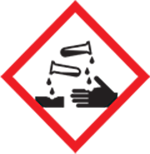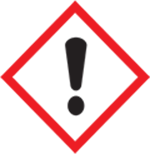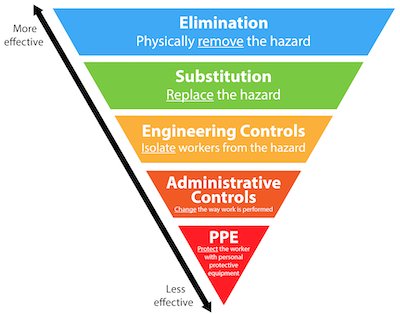Chromium III Chloride Hexahydrate
This chemical standard operating procedure (SOP) and the associated Safety Data Sheet (SDS) are for our safety. Read and understand both documents. If this is a paper copy, check for updated versions on the IsoLab website.
Process
Chromium III chloride hexahydrate is used as part of our Chromium Reduction SOP to extract pyrite bound sulfur.
Hazards - SDS



May be corrosive to metals. Harmful if swallowed. May cause an allergic skin reaction. Toxic to aquatic life with long lasting effects.
Protection - SDS

Engineering Controls
Use chromium III chloride hexahydrate in a fume hood. Ensure the fume hood has proper air flow by checking the flow rate on the control panel and / or using a smoke match or wipe to visualize flow. Place one of the mobile balances into the fume hood for weighing this chemical.
PHS - Any fume hood in the IsoLab suite will be sufficient.
Administrative Controls
PHS - No administrative controls are required.
Personal Protective Equipment (PPE)
Wear a laboratory coat, gloves, and eye protection.
PHS - Don lab coat, nitrile gloves, and eye protection before grabbing the bottle.
Handling - SDS
Keep container tightly closed when not in use. Keep away from metals. Keep in original container.
PHS - Decontamination - After making the chromium chloride in HCl solution, make sure all glassware is rinsed with waste going into your labeled waste container.
Storage - SDS
Chromium III chloride hexahydrate must be stored in 303B on the north wall on shelf #8. Use MyChem, the UW EH&S chemical inventory database, for more details on storage within the lab suite. Store in original container.
Spills - SDS
Avoid dust formation. Don respirator, lab coat, gloves, and eye protection if spill is outside fume hood. Prevent from entering drain or otherwise being released into the environment.
PHS - Exposure:
- Inhalation - If breathed in, move person into fresh air. If not breathing, give artificial respiration. For advice, call UW Employee Health Center (206.685.1026) or the Washington Poison Center (800.222.1222). For emergency help, call 911.
- Skin contact - Wash off with soap and plenty of water. For advice, call UW Employee Health Center (206.685.1026) or the Washington Poison Center (800.222.1222). For emergency help, call 911.
- Eye contact - Flush eyes with water as a precaution. For advice, call UW Employee Health Center (206.685.1026) or the Washington Poison Center (800.222.1222). For emergency help, call 911.
If the spill is contained within the fume hood, close the sash and prepare yourself for cleanup. Prevent from entering drain or otherwise being released into the environment. Avoid dust formation.
If you need assistance or advice, use the IsoLab Emergency Contacts sheet.
Consult the EH&S Spill Poster and Exposure Poster
Waste - SDS
If you are cleaning up after a spill and have a bag of debris, ensure the bag is sealed and use multiple bags as needed. Complete an EH&S Hazardous Waste Label and adhere it to the bag. Here are instructions for how to label chemical waste containers. Labels are located in a drawer on the west wall of 303B near the door to the hallway.
Put all waste, solid or liquid, into a wide mouth plastic container. Options for waste containers can be found under the west sink in 303B. Complete an EH&S Hazardous Waste Label and adhere it to the bottle. Here are instructions for how to label chemical waste containers. Labels are located in a drawer on the west wall of 303B near the door to the hallway.
Place the properly labeled container in one of the gray tubs near the hallway door of 303B. Segregate from other waste containers as appropriate.
Consult our generalized Chemical Waste Disposal SOP.

Training - PHS
Chromium III chloride hexahydrate is deemed a particularly hazardous substance - PHS by EH&S and you need approval before using it. Complete the list of requirements below before using this chemical.
Prerequisites
- You must have completed Managing Laboratory Chemicals in the last three years. Login to check.
- Read and understand the SDS for Chromium III chloride hexahydrate.
- Read, understand, and digitally sign this SOP.
- Contact your Principal Investigator (PI) AND the Chemical Hygiene Officer (CHO) indicating that you have completed all prerequisites and await approval.
